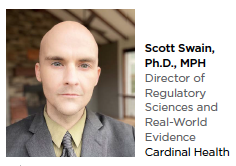 Interest in using real-world data (RWD) in drug development and regulatory submissions has grown substantially over the past several years. This development can largely be attributed to passage of the 21st Century Cures Act, which mandated that FDA establish a program to evaluate the use of real-world evidence (RWE) to support approval of new indications for drugs, and the subsequent FDA release of a strategic framework for using RWD to improve regulatory decisions.
Interest in using real-world data (RWD) in drug development and regulatory submissions has grown substantially over the past several years. This development can largely be attributed to passage of the 21st Century Cures Act, which mandated that FDA establish a program to evaluate the use of real-world evidence (RWE) to support approval of new indications for drugs, and the subsequent FDA release of a strategic framework for using RWD to improve regulatory decisions.
The growing focus on RWD reflects an acknowledgement by the healthcare community and regulators that clinical trial data alone may not present a complete picture of the safety and effectiveness of pharmaceutical products because clinical trial patients may not be representative of the general population. Rather, trial participants are typically younger, healthier, and less diverse than patients who do not participate.
Although a clinical trial is, and likely always will remain, the gold standard for safety and efficacy estimation, many drug developers are exploring how RWE can complement and expand on clinical trial evidence in regulatory submissions. Specifically, there is growing focus on the use of RWE in in pre-marketing drug studies that support regulatory applications.
As drug developers begin to explore the use of RWD in clinical trials and regulatory submissions, there are four key considerations that must be evaluated:
1. Data Fragmentation
When assessing the opportunity to use RWD, one of the biggest challenges for researchers is data continuity. Patients do not always receive care at the same hospital or clinic, or get their prescriptions filled at the same pharmacy. They change health care plans and insurers. Different institutions may use different EHRs or have different practices for how test results are documented, which make it difficult to capture outcomes that occur over longer periods of time.
2. Privacy
Another consideration related to data fragmentation is privacy. In the United States, RWD containing personal identifiers is protected by HIPAA enacted in 1996. It protects individual privacy rights for the use and disclosure of protected health information (PHI). Because patient data is often de-identified for privacy and data security reasons, integrating it with other data to create a more complete picture of that patient’s experience can be a challenge for researchers.
3. Data Quality, Accuracy, and Completeness
RWD is generally not equivalent to clinical trial data because of differences in healthcare settings and the rigor of the clinical trial design. The quality, accuracy, and completeness of RWD can vary, depending on a variety of factors, including adherence, treatment administration method, the outcome being measured, and how the RWD was measured and ascertained.
4. Context
Another limitation of RWD is the inherent bias which results as a direct consequence of its being recorded in real-world healthcare settings. Typically, real-world studies use data that was recorded for a different purpose, such as insurance billing or medical records. Researchers trying to assimilate information out of data that was reported for an alternative purpose to suit a new purpose may find the data does not translate well. This is primarily a problem when directly comparing RWD to clinical trial data.
While these considerations and potential challenges are important to understand, they should not deter drug developers from incorporating RWD into regulatory submissions. In fact, the FDA’s current focus on RWD indicates there is never been a better time to evaluate how RWD can help accelerate the approval timeline for your therapy or reduce the total cost of development.
However, it is important to take a calculated approach — and to draw upon know-how of those with experience designing RWD trials and analyzing the data. RWD must be fit for purpose whether its intended use is for market research or regulatory submission, and whether RWD is appropriate, acceptable, or valuable for this purpose depends strongly on the many factors specific to each drug application (i.e.: drug class, indication, safety/efficacy profile, prognosis of the patients, alternative treatment options, etc.). Because this is a nascent area of drug development, working with an expert partner can help ensure that you are following the appropriate data standards, effectively engaging with the FDA throughout the process — and most importantly, avoiding costly missteps.(PV)
The Real-World Evidence and Insights experts at Cardinal Health work with key stakeholders to critically analyze data and deliver clinically and scientifically meaningful results to inform all phases of the product lifecycle.
To learn more, visit cardinalhealth.com/RWE.










